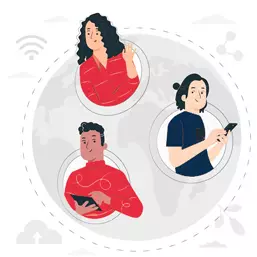
Developing Non-Verbal Communication Skills
The problem with communication is the illusion that it has been accomplished.
– George Bernard Shaw
Introduction
Face-to-face communication is an example of interpersonal communication, which refers to the process by which individuals interact information, sentiments, and meaning with one another via the use of spoken and non-verbal communications.
Communication between people is not simply about the words that are spoken; rather, it is also about how those words are exchanged and the non-verbal meanings that are sent via a person’s tone of voice, facial expressions, gestures, and overall body language.
When two or more individuals are in the same location and are aware of each other’s existence, communication is going place, even if it is indirect or inadvertent. This is true even if the persons do not speak the same language.
It is possible for an observer to acquire an impression of another person’s role, emotional state, personality, or goals even in the absence of spoken communication by employing clues such as posture, facial expression, and clothes. Even when there is no intention to communicate, individuals are nevertheless able to decipher the signals sent by various types of non-verbal behaviour.
When we refer to “communication,” we often mean, “what we say,” which refers to the actual words that are exchanged. However, the explicit meaning of words and the information or message that they represent is just a small part of what is involved in effective interpersonal communication. It also contains unintended or not, implicit signals that are sent by nonverbal behaviours. These messages may be either positive or negative.
The distance between the communicators is also a kind of non-verbal communication. Facial expressions, the tone and pitch of the voice, gestures exhibited via body language (kinesics), and physical distance are all examples of non-verbal communication (proxemics).
In addition to the information sent via spoken (verbal) communication, these non-verbal cues may also convey extra information and deeper meaning. According to some estimations, nonverbal communication accounts for anywhere between 70 and 80 percent of all communication.
Communication is not just about what comes out of our mouths. In fact, what we don’t say — our body language, voice intonation and use of silence —- often sends a louder message to other people than the words we say. Unless we actively practice non-verbal communication skills, we can’t really be sure if we’re actually sending the message that we want to send.
Brief check
It is important to remember that effective verbal communication cannot be fully isolated from non-verbal communication: your body language, tone of voice, and facial expressions, for example.
Non-verbal communication helps people to:
Reinforce or modify what is said in words: People are able to reinforce or change what is conveyed in words with the assistance of non-verbal communication. When someone says “Yes,” for instance, they could enthusiastically nod their heads in order to emphasize that they agree with the person they are speaking to. When someone says, “I’m good, thanks,” but then shrugs their shoulders and has a sorrowful expression on their face, it may really be implying that things are not really all right at all!
Convey their current emotional state: Even if you haven’t uttered a word, the look on your face, the way you speak, and the way you carry yourself may often communicate your thoughts and feelings to others around you. Think about the number of times that you’ve asked someone, “Are you okay?” You seem to be in a glum mood.” Because of how individuals express themselves non-verbally, we may infer how they are feeling.
Establish or strengthen the nature of the interaction between the individuals: If you’ve ever seen a couple having a conversation while sitting together, you may have noticed that they have a tendency to “mirror” one other’s body language. They are smiling at each other at the same moment, holding their hands in a same manner, and turning their bodies to face each other more directly. These actions strengthen their connection with one another; they deepen their rapport with one another and make them feel more connected to one another.
Provide the other individual with feedback: When you smile and nod at someone, it shows that you are paying attention to what they are saying and that you agree with what they are saying. It’s possible that you want to converse by moving around and making hand motions. These tiny signals provide information in a soft but unmistakable manner.
Maintain order in the dissemination of information: There are a variety of cues that we might provide to others to indicate that we are through speaking or that we would want to take the floor again. For example, when we have nothing further to say, we can communicate this with a resounding nod and a resolute puckering of the lips. You may signal that you would like to speak by making eye contact with the person who is presiding over the meeting and giving a modest nod.

Acquiring Knowledge of the Language
There are a number of popular books that treat the issue of non-verbal communication as if it were a language that can be learnt. The implication of these books is that if the meaning of every nod, eye movement, and gesture were known, a person’s true sentiments and intentions might be understood. This is, without a doubt, one hundred percent accurate.
Non-verbal communication is not a language with a single, agreed-upon meaning, deciphering it may be a challenging and time-consuming endeavour. For that reason, the setting in which non-verbal communication takes place has a strong impact as well as helps to drive the development of communication between individuals. This encompasses not just the location but also the people who live there and the culture as a whole.
For instance, a simple nod of the head between co-workers at a committee meeting may signify something completely different than when the same motion is used to recognize someone across a packed room, and again when two individuals are having a social discussion with one another.
Additionally, non-verbal communication may be both aware and unconscious at the same time. Because we cannot see ourselves, it is very difficult to maintain control over our facial expressions and know how we are coming across to others. Because of this, we could make communication more difficult by attempting to send one message consciously while really communicating an entirely other meaning subconsciously.
Communication between people is made much more difficult by the fact that it is almost never possible to correctly understand a gesture or emotion based just on that action or expression. Expressions, hand and eye movements, postures, and gestures are all components of non-verbal communication that should be understood in conjunction with speech. Non-verbal communication comes as a full package (verbal communication).
Writing as a Form of Non-Verbal Communication
The idea that written words also includes non-verbal information is one that has been debated by a lot of individuals over the years. Your choice of font and color, in addition to your handwriting, might convey hints about how you were feeling at the time, for example, that you penned a message. In today’s world, your choice of typeface and color also tells something about you.

On the other hand, it is now widely acknowledged that the aforementioned modes of non-verbal communication are not very trustworthy markers of character. They provide a far lower amount of information in comparison to the non-verbal communication that is an integral aspect of face-to-face conversations.
The cultural context
The good news is that as we mature and get older, the vast majority of us pick up the ability to understand and decode non-verbal forms of communication. It is a natural component of the way in which we connect with one another, and the majority of the time; we do not only utilize it but also interpret it very instinctively.
Because of this, it may become more difficult to interpret consciously. However, if you stop thinking about it, you will most likely discover that you have a pretty good sense of what someone meant. This will become apparent once you stop thinking about it.
The bad news is that culture may have a significant role in how non-verbal communication is interpreted. Here are some examples of nonverbal communication that are unique to a certain culture –
1. Although the typical stereotype of Italians, which involves making large gestures, a lot of hand waving, and much of loud and impassioned yelling, may be a stereotype, there is a reason why it exists. When compared to, say, the culture of the United Kingdom, the expression of excitement is far more overt in Italian society. Communication that is not verbal has a tendency to be a great deal more visible. Because of this, it may be much more challenging for Italians to read non-verbal communication in the United Kingdom or the United States, where it is often more nuanced. Nevertheless, even within Italy, there are significant regional differences.
2. The gesture of giving a thumbs-up, which is commonly understood to indicate acceptance in English-speaking nations, is seen as insulting in other countries, including, reportedly, Greece, Italy, and some regions of the Middle East.
3. In Western cultures, the sign for all right is to make a circle with your thumb and fingers as seen above. In this specific capacity, divers are the ones who make use of it. On the other hand, rumour has it that in Japan it is a gesture for money, and in Arabic-speaking areas it is a threat.

The Importance of Communicating Through Non-Verbal Means
It is necessary to keep in mind that the meaning of our non-verbal signals may be just as significant as the meaning of what we say, and in some situations even more important. People have a tendency to have a lot less conscious control over the signals they send via their non-verbal communication than they do over the words they actually utter. This is due, in part, to the fact that non-verbal communication is far more emotional in its makeup and, as a result, significantly more instinctual.
Therefore, if there is a discrepancy between the two, you should generally put more stock in the non-verbal cues rather than the words that are being communicated. It’s possible that the speaker is attempting to conceal their genuine feelings by carefully managing their body language, and the absence of any non-verbal messages might be seen as a signal that they’re succeeding.
Brief check
Body language refers to the messages we send to other people through our posture, facial expression, gestures, and bodily movements.
Different modes of communication that do not use words
It is believed that a listener pays more attention to body language than verbal messages. This implies that if one’s body language is inconsistent with the verbal message being sent (e.g. frowning while saying you’re happy), the verbal message becomes less credible. In fact, such inconsistency can even nullify the verbal message, and result to the verbal message being perceived as a lie. At the very least, inconsistencies between verbal and non-verbal communication can result in confusion.
There are a great number of non-verbal communication styles to choose from. They consist of the following:
Body motions (kinesics), such as hand gestures or nodding or shaking the head, which are often the elements of non-verbal communication that are the simplest to regulate. There are specific movements that have traditionally been associated with certain messages. For example, nodding is generally a sign of assent or agreement. Raising clenched hands are interpreted as a sign of angry challenge. Stomping our feet can be an indication of frustration.
Your posture, which includes how you stand, or sit, whether or not you have your arms crossed, and so on can also communicate. For example, slumping in a chair is often considered as a sign of inattention and or disrespect. Walking with one’s head and shoulders down can be interpreted as a sign of nervousness or low self-esteem. Withdrawing to a fetal position can also be indicative of fear and or depression. The puffing of one’s chest has been traditionally interpreted as pride.
Eye contact, the quantity of which, studies have shown, is a strong predictor of a person’s degree of trustworthiness and confidence. Eye contact is considered one of the most important aspects of non-verbal communication. Steady eye contact often indicates attention to the person one is in conversation with, as well as a willingness and sincerity to connect. The lack of eye connect can be viewed as defensiveness, nervousness and or social withdrawal. Many say that our eyes are the “windows to our soul”, and that one can tell if an individual is happy, sad, or angry simply by looking at their eyes.
Paralanguage, also known as elements of the voice that are distinct from speech and include pitch, tone, and rate of speech;
Proxemics, also known as proximity or personal space, is what ultimately defines the amount of closeness between two people, and it varies greatly from culture to culture. Standing too close to a person can be considered as an invasion of boundaries, while standing too far from a person can be construed as avoidance.
Facial expressions, such as smiling, frowning, and blinking, are difficult to consciously regulate. This is especially true of the former. It’s fascinating to note that people all throughout the globe have the same wide facial expressions for expressing powerful emotions like fear, rage, and delight. For example, anger is often indicated by sharp stares, crunched eyebrows and the baring of teeth. Teary eyes and drooping lips, on the other hand, can denote sadness. Note though that the expression and perception of emotions tend to vary from culture to culture.
and
Changes in your body’s physiology, such as when you are anxious, you may perspire more, blink more often, and experience an increase in the pace of your heartbeat. Because of how difficult it is to actively exert control over them, they are a particularly useful indication of one’s current mental state.
Physical contact or the way we physically interact with other people is also a part of body language. Shaking of hands, hugging, slapping, punching are forms of communication.
The message you send out
Generally, our non-verbal communication is something that we do unconsciously. Many things, including past habits, life experiences, personal models, culture and hidden thoughts and feelings, can influence it. Because body language is often outside of awareness, most have no idea what it is exactly that they are communicating to other people.
To take control of the signals that we send to others, it’s important that we become much more deliberate and purposive in communicating non-verbally.
The following are some tips and techniques you can follow to be able to use body language effectively.
Increase your awareness of your body language. Try to get more information about what you communicate non-verbally, so that you will know what to change and what to retain. Ways you can do this include: watching a videotape of yourself, studying yourself in front of a mirror, and getting feedback from peers and friends.
Know how certain behaviours are typically interpreted. Interpreting body language can be very subjective. There are, however, typical interpretations to specific body language. Increasing awareness of what body language is often associated with what interpretation, can help a person avoid body language incongruent with the message they want to send; as well as deliberately practice the body language congruent with their message.
Practice! Practice! Practice! Body language is a skill. Initially, using body language that is congruent with the message that we want to communicate will feel unnatural. But just keep on working on it. Soon, it’ll be second nature to you!
The message that you convey to others
In most cases, our non-verbal communication is something that we do without even realizing that we are doing it. It can be influenced by a variety of factors, such as past routines, life experiences, personal models, culture, and even thoughts and feelings that are kept secret. Most people are unaware of what it is that they are actually conveying to other people through their body language because it is so frequently below the threshold of conscious awareness. It is essential for us to become significantly more deliberate and purposeful in the way that we communicate non-verbally if we wish to regain control over the messages that we give to other people. In order for you to be able to make effective use of body language, the following is a list of some guidelines and tactics you can follow.
Strive to become more self-aware of your own body language: You should make an effort to get more information on what you communicate non-verbally so that you will have a better idea of what should be altered and what should be kept the same. You can accomplish this goal in a number of different ways, such as by seeing yourself in front of a mirror, watching a recording of yourself, or soliciting the opinion of your contemporaries and close friends.
Be aware of the conventional meanings attributed to particular behaviours: The interpretation of body language can be quite open to personal interpretation. However, there are commonly accepted meanings attached to certain types of body language. A person can avoid sending a message that is incongruent with their body language by increasing their awareness of what body language is commonly associated with what interpretation. They can also deliberately practice using body language that is congruent with the message they want to send by increasing their awareness of what body language is congruent with their message.
Mastering body language requires practice: At first, it will feel weird to use body language that is congruent with the message that we want to transmit. But just keep on working on it. It won’t be long before it becomes automatic for you! It is important how one communicates. The manner in which information is conveyed is also considered part of non-verbal communication. Modifying a statement’s tone and inflection, even slightly, can completely transform its original meaning. Because of this, it is essential to be conscious of the way that we speak in order to improve the efficiency of our communication. The following is a list of aspects of “how we say things” that should be taken into consideration by us:
Inflection of the Voice: The process of altering one’s pitch in order to communicate effectively is referred to as voice intonation. For instance, one can convey the same message by utilizing an ascending intonation, a descending intonation, or a falling intonation. All of these intonations are considered variations on the same theme. Communications can be made to seem either happy or gloomy depending on the speaker’s tone, which can be used to help inject emotions into the messages. Alterations in a sentence’s tonal quality can also be used to assist in determining the purpose of the sentence. There are intonations that are more appropriate for posing questions, and there are intonations that are more appropriate for making statements.
Stress and emphasis: The meaning of a phrase can be altered by changing which words or syllables are emphasized in the phrase. Take, as an illustration, the discrepancies between the three statements that are presented below. The term that is italicized indicates where the emphasis should be placed.
You mean he disobeyed the orders of his mother?
You mean he disobeyed the orders of his mother?
You mean he disobeyed the orders of his mother?
Pace and Rhythm: The speed of speech, as well as the right use of pauses, can modify the meaning of the words that are spoken, and can affect the clarity and efficacy of a communication. Pace and rhythm are both important aspects of public speaking. People who talk too quickly, for instance, might be challenging to communicate with because the listener could feel as though they are under too much pressure to understand all that is being said. On the other hand, a someone who speaks too slowly may cause their audience to become bored.
Volume: When it comes to communication, how softly or loudly you speak can be just as important as the other. When one is in the company of other people, they should try to speak at a volume that is somewhere between too soft and too loud. A voice that is too soft can express uneasiness or a lack of assertiveness, while a voice that is too loud can communicate hostility and aggression. A person should also be adaptable and have the ability to whisper or shout appropriately depending on the situation.
The difference between pronouncing and enunciating. Pronunciation and enunciation play a role in the clarity with which a message is communicated. Speaking a word in a form that is commonly accepted or understood is what is meant by the term “pronunciation,” whereas the act of speaking clearly and concisely is what is meant by the term “enunciation.” It is possible to increase one’s likelihood of being correctly understood by working on improving one’s pronunciation and enunciation skills. It is important to keep in mind that different accents might result in a variety of different pronunciations being regarded appropriate.
Brief check
Non-verbal communication can have a great impact on the listener and the outcome of the communication.
Conclusion
The ability to communicate effectively via non-verbal means is not only a difficult talent to acquire but also an essential one. On the other hand, individuals are often wholly oblivious to their own non-verbal behaviour. Enhancing your contact with people may be made easier by developing even a basic understanding of non-verbal communication tactics. These strategies go beyond what is actually expressed. Knowing these indicators may be used to encourage people to speak about their issues, which can ultimately lead to a more shared understanding, which is ultimately the goal of communication. Knowledge of these indications can be used to urge people to talk about their problems.

Practical Application
James, a former army officer, was adjusting to life as a manager at a mid-sized office while he was in the process of making the transition. George, one of his co-workers, informed him one day that the people who worked for him feared him and his authority. George elucidated the fact that he always appeared to be highly combative while he was providing directions. When John was talking to his staff, George gave him the advice to try to relax as much as possible. Even though James took George’s suggestion and implemented it, his staff continued to find John to be scary. When he asked them for their own recommendations, they told him that even though he had a friendly body language, he was still yelling out instructions like a drill sergeant even though his body language was kind. After some reflection, James realized that the tone of his voice and the way he carried himself in public were equally crucial components of communication.





